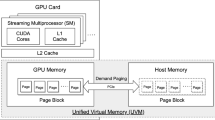Abstract
This paper describes external reference management and distributed unification in a distributed implementation of a concurrent logic programming language KL1. This implementation is based on the KLIC system. KLIC has a feature calledgeneric objects that enable easy modification and extension of the system without changes in the core implementation. This distributed implementation is built upon the same core and external references are represented using generic objects. Unification operations are defined as methods of generic objects. Since creation of interprocessor reference loops cannot be avoided, we studied a new unification scheme that can cope with interprocessor reference loops. We built several experimental distributed systems that all demonstrate reasonable efficiency.
Similar content being viewed by others
References
Ueda, K. and Chikayama, T., “Design of the Kernel Language for the Parallel Inference Machine,”The Computer Journal, 33, 6, pp. 494–500, 1990.
Nakajima, K., Inamura, Y., Ichiyoshi, N., Rokusawa, K., and Chikayama, T., “Distributed Implementation of KL1 on the Multi-PSI/V2,”Proc. International Conference on Logic Programming, pp. 436–451, 1989.
Hirata, K., Yamamoto, R., Imai, A., Kawai, H., Hirano, K., Takagi, T., Taki, K., Nakase, A., and Rokusawa, K., “Parallel and Distributed Implementation of Concurrent Logic Programming Language KL1,”Proc. International Conference on Fifth Generation Computer Systems, pp. 436–459, 1992.
Chikayama, T., “Operating System PIMOS and Kernel Language KL1,”Proc. International Conference on Fifth Generation Computer Systems, pp. 73–88, 1992.
Nitta, K., Taki, K., and Ichiyoshi, N., “Experimental Parallel Inference Software,”Proc. International Conference on Fifth Generation Computer Systems, pp. 166–190, 1992.
Chikayama, T., Fujise, T., and Sekita, D., “A Portable and Efficient Implementation of KL1,”Proc. International Symposium on Programming Language Implementation and Logic Programming, LNCS 844, pp. 25–39, 1994.
Fujise, T., Chikayama, T., Rokusawa, K., and Nakase, A., “KLIC: A Portable Implementation of KL1,”Proc. International Symposium on Fifth Generation Computer Systems, pp. 66–79, 1994.
Carlsson, M., Widén, J., Andersson, J., Andersson, S., Boortz, K., Nilsson, H., and Sjöland, T.,SICStus Prolog User’s Manual, 1993.
Janson, S., Montelius, J., Boortz, K., Brand, P., Carlson, B., Haygood, R. C., Danielsson, B., and Haridi, S., “AGENTS User Manual,”SICS Technical Report, 1994.
Ichiyoshi, N., Rokusawa, K., Nakajima, K., and Inamura, Y., “A New External Reference Management and Distributed Unification for KL1,”New Generation Computing, pp. 159–177, 1990.
Foster, I. and Taylor, S.,Strand: New Concepts in Parallel Programming, Prentice-Hall, 1989.
Foster, I. and Taylor, S., “Strand: A Practical Parallel Programming Tool,”Proc. North American Conference on Logic Programming, pp. 497–512, 1989.
Ueda, K., “Guarded Horn Clauses: A Parallel Logic Programming Language with the Concept of a Guard,”ICOT Technical Report, TR-208, 1986.
Shapiro, E., “Systems Programming in Concurrent Prolog,”Logic Programming and Its Applications (M. van Canegham and D.H.D. Warren, eds.), Albex Publishing Co., pp. 50–74, 1986.
Clark, K. and Gregory, S., “PARLOG: Parallel Programming in Logic,”ACM Transactions on Programming Languages and Systems, 8, 1, pp. 1–49, 1986.
Saraswat, V. A., Kahn, K., and Levy, J., “Janus: A Step Towards Distributed Constraint Programming,”Proc. North American Conference on Logic Programming, pp. 431–446, 1990.
Watson, P. and Watson, I., “An Efficient Garbage Collection Scheme for Parallel Computer Architectures,”Proc. Parallel Architectures and Languages Europe, LNCS 259, Vol. II, pp. 432–443, 1987.
Bevan, D. I., “Distributed Garbage Collection Using Reference Counting,”Parallel Computing, 9, 2, pp. 179–192, 1989.
Geist, A., Beguelin, A., Dongarra, J., Jiang, W., Manchek, R., and Sunderam, V.,PVM 3 USER’S GUIDE AND REFERENCE MANUAL, Oak Ridge National Laboratory, Tennessee, 1994.
Murao, H. and Fujise, T., “Modular Algorithm for Sparse Multivariate Polynomial Interpolation and Its Parallel Implementation,”Proc. International Symposium on Parallel Symbolic Computation, pp. 304–315, 1994.
Ishikawa, M., Toya, T., and Totoki, Y., “Parallel Application Systems in Genetic Information Processing,”Proc. International Symposium on Fifth Generation Computer Systems, pp. 129–138, 1994.
Ichiyoshi, N., Morita, M., and Chikayama, T., “A Shared- Memory Parallel Extension of KLIC and Its Garbage Collection,”Proc. FGCS’94 Workshop on Parallel Logic Programming, pp. 113–126, 1994.
Author information
Authors and Affiliations
Additional information
Research and Development Group, Oki Electric Industry Co., Ltd., since April 1, 1995.
Research and Development Center, Toshiba Corporation, since April 1, 1995.
Department of Electronic Engineering, University of Tokyo, since April 1, 1995.
Kazuaki Rokusawa: He received the BS and MS degrees in electrical engineering from Waseda University, Tokyo, Japan, in 1981 and 1983, respectively. Since 1983, he has been a researcher at Oki Electric Industry Co., Ltd. He worked at the Institute for New Generation Technology (ICOT) during 1986–1990 and 1993–1995. His current research interests include concurrent logic programming, parallel language implementation, and distributed processing.
Akihiko Nakase: He received the bachelor’s and master’s degree in electrical engineering from Waseda University, Tokyo, Japan, in 1984 and 1986, respectively. Since 1986, he has been a researcher at TOSHIBA Research and Development Center. From 1993 to 1994, he worked for the Institute for New Generation Technology (ICOT). He developed basic software of parallel knowledge based machine and parallel inference machine in TOSHIBA, and distributed memory implementation of KLIC system in ICOT.
Takashi Chikayama: He received the B. Eng. degree in Mathematical Engineering and Information Physics in 1977 and the Dr. Eng. degree in Information Engineering in 1982, both from the University of Tokyo. He worked at the Institute for New Generation Computer Technology (ICOT) from 1982 to 1995. Since 1995, he has been an associate professor at Dept. of Electronic Engineering, the University of Tokyo. His current research interests include design and implementation of programming languages, software development support systems, and operating systems.
About this article
Cite this article
Rokusawa, K., Nakase, A. & Chikayama, T. Distributed memory implementation of KLIC. New Gener Comput 14, 261–280 (1996). https://doi.org/10.1007/BF03037484
Received:
Revised:
Issue Date:
DOI: https://doi.org/10.1007/BF03037484




